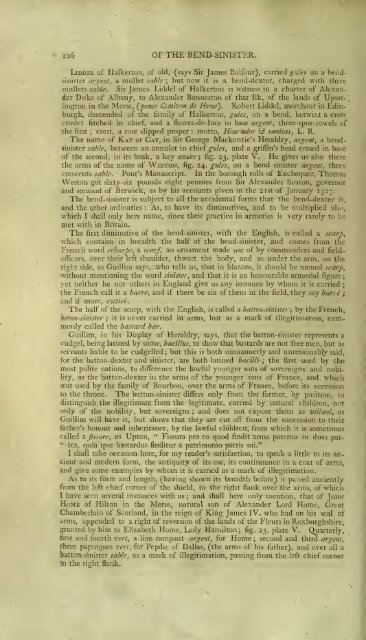A System of Heraldry - Clan Strachan Society
A System of Heraldry - Clan Strachan Society
A System of Heraldry - Clan Strachan Society
Create successful ePaper yourself
Turn your PDF publications into a flip-book with our unique Google optimized e-Paper software.
afi OF THE BEND-SINISTER.<br />
LIDDEL <strong>of</strong> Halkerton, <strong>of</strong> old, (says Sir James Balfour), carried 'gules on a bencJ-<br />
sinister argent, a mullet sable ; but now it is a bend-dexter, charged with tl<br />
mullet? tabfe. Sir James Liddel <strong>of</strong> Halkerton is witness in a charter <strong>of</strong> 'Alexander<br />
Duke <strong>of</strong> Albany, to Alexander Bonneston <strong>of</strong> that Ilk, <strong>of</strong> the lands <strong>of</strong> Upsat-"<br />
lington in the Merse, (penes Ctmitem de Home').<br />
Robert Liddel, merchant in Edin-<br />
burgh, descended <strong>of</strong> the family <strong>of</strong> Halkerton, gules, on a bend, betwixt a cross<br />
croslet fitched in chief, and a flower-de-luce in base argent, three spur-rowels <strong>of</strong><br />
the first ; crest, a rose slipped proper : motto, Hinc odor y sanitas, L. R.<br />
The name <strong>of</strong> KAY or CAY, in Sir George Mackenzie's <strong>Heraldry</strong>, argent, a bendsinister<br />
sable, between an annulet in chief gules, and a griffin's head erased in base<br />
<strong>of</strong> the second, in its beak, a key azure ; fig. 23. plate V. He gives us also there<br />
the arms <strong>of</strong> the name <strong>of</strong> WESTON, fig. 24. gules, on a bend sinister argent, three<br />
crescents sable. Font's Manuscript. In the borough rolls <strong>of</strong> Exchequer, Thomas<br />
Weston got sixty-six pounds eight pennies from Sir Alexander Scaton, governor<br />
and steward <strong>of</strong> Berwick, as by his accounts given in the 2ist <strong>of</strong> January 1327.<br />
The bend-sinister is subject to all the accidental forms that the bend-dexter i?,<br />
and the Qther ordinaries : As, to have its diminutives, and to be multiplied also,<br />
which I shall only here name, since their practice in armories is very rarely to be<br />
met with in Britain.<br />
The first diminutive <strong>of</strong> the bend-sinister, with the English, is called a<br />
scarp,<br />
which contains in breadth the half <strong>of</strong> the bend-sinister, .and comes from the<br />
French word echarpe, a scarf, an ornament made use <strong>of</strong> by commanders and field-<br />
<strong>of</strong>ficer?, over their left shoulder, thwart the body, and so under the arm, on the<br />
right side, as Guillim says, who tells us, that in blazons, it should be named scarp,<br />
without mentioning the word sinister, and that it is an honourable armorial figure ;<br />
yet neither he nor others in England give us any instance by whom it is carried ;<br />
the French call it a barre, and if there be six <strong>of</strong> them in the field, they say ban e i<br />
and if more, cottise,<br />
The half <strong>of</strong> the scarp, with the English, is called a batton-sinister; by the French,<br />
baton -sinister ; it is never carried in arms, but as a mark <strong>of</strong> illegitimat'on, com-<br />
monly called the bastard bar.<br />
Guillim, in his Display <strong>of</strong> <strong>Heraldry</strong>, says, that the batton-sinister represents a<br />
cudgel, being latined by some, bacillus, to show that bastards are not free men, but as<br />
servants Kable to be cudgelled; but this is both unmannerly and unreasonably said,<br />
for the batton-dexter and sinister, are both latined bacilli ; the first used by the<br />
most polite nations, to difference the lawful younger sons <strong>of</strong> sovereigns and nobility,<br />
as the batton-dexter in the arms <strong>of</strong> the younger sons <strong>of</strong> France, and which<br />
was used by the family <strong>of</strong> Bourbon, over the arms <strong>of</strong> France, before its accession<br />
to the throne. The button-sinister differs only from the former, by position, to<br />
distinguish the illegitimate from the legitimate, carried by natural children, not<br />
only <strong>of</strong> the nobility, but sovereigns ; and does not expose them as villain, as<br />
Guillim will have it, but shows that they are cut <strong>of</strong>t" from the succession to their<br />
tather's honour and inheritance, by the lawful children, from which it is sometimes<br />
called afasure, as Upton, " Fissura pro eo quod findit anna paterna in duas par-<br />
" tcs, quia ipse bastardus finditur a patrimonio patris sui."<br />
I shall take occasion here, for my reader's satisfaction, to speak a little to its an-<br />
cient and modern form, the antiquity <strong>of</strong> its use, its continuance in a coat <strong>of</strong> arms,<br />
and give some examples by whom it is carried as a mark <strong>of</strong> illegitimation.<br />
As to its form and length, (having shown its breadth before), it pa: sed anciently<br />
from the left chief corner <strong>of</strong> the shield, to the right flank over the arms, <strong>of</strong> which<br />
I have seen several instances with us ; and shall here only mention, that <strong>of</strong> JOHN<br />
HOMJS <strong>of</strong> Hilton in the Merse, natural son <strong>of</strong> Alexander Lord Home, Great<br />
Chamberlain <strong>of</strong> Scotland, in the reign <strong>of</strong> King James IV. who had on his seal <strong>of</strong><br />
arms, appended to a right <strong>of</strong> reversion <strong>of</strong> the lands <strong>of</strong> the Fleurs in Roxburghshire,<br />
granted by him to Elizabeth Home, Lady Hamilton; fig. 25. plate V. Quarterly,<br />
first and fourth vert, a lion rampant argent, for Home ; second and third argent,<br />
three papingoes vert, for Pepdie <strong>of</strong> Dallas, (the arms <strong>of</strong> his father), and over all a<br />
batt.oTj-sinister sable, as a mark <strong>of</strong> illegitimation, passing from the left chief corner<br />
to the right flank.




